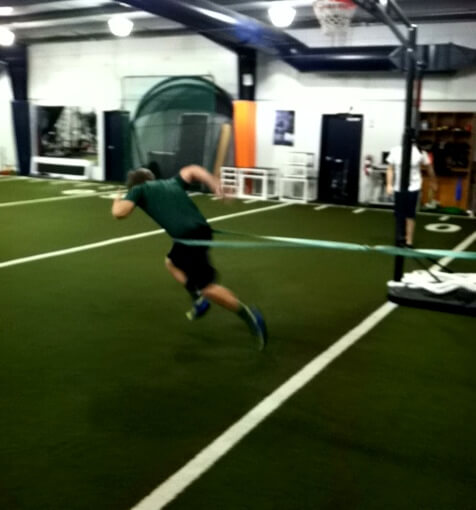If you haven't read parts 1 and 2 please do so before going any further. In part three of our series of why you're not fast we examine the effects of your body composition and speed. Body composition is the makeup of the human body as it relates to muscle, bone, fat, etc. Typically body composition measurements are broken down into what is called a 2-compartment model. The 2-compartment model compares fat percentage or fat mass vs. fat free percentage or lean mass. This comparison tells us how much of our overall mass is working to make us faster (lean) vs. how much is making us slower (fat). We all need a certain level of fat to function effectively but once we reach a certain threshold that extra weight will start to limit how fast we can go. The actual percentages vary from gender and age along with sports and positions.
Body Fat Percentages for the Athletic Population
| Sport | Male | Female | Sport | Male | Female |
| Baseball | 12-15% | 12-18% | Rowing | 6-14% | 12-18% |
| Basketball | 6-12% | 20-27% | Shot Putter | 16-20% | 20-28% |
| Body building | 5-8% | 10-15% | Skiing (X country) | 7-12% | 16-22% |
| Cycling | 5-15% | 15-20% | Sprinters | 8-10% | 12-20% |
| Football (backs) | 9-12% | No Data | Soccer | 10-18% | 13-18% |
| Football (Lineman) | 15-19% | No Data | Swimming | 9-12% | 14-24% |
| Gymnastics | 5-12% | 10-16% | Tennis | 12-16% | 16-24% |
| High/Long Jumpers | 7-12% | 10-18% | Triatholon | 5-12% | 10-15% |
| Ice/Field Hockey | 8-15% | 12-18% | Volleyball | 11-14% | 16-25% |
| Marathon Running | 5-11% | 10-15% | Weightlifter | 9-16% | No Data |
| Racquetball | 8-13% | 15-22% | Wrestler | 5-16% | No Data |
*This is an expert from Sport Nutrition, Second Edition, by Asker Jeukendrup, PhD, and Michael Gleeson, PhD.
Although not the only factor excess body-fat can significantly limit an athlete's top speed, agility and running efficiency along with adding stress to the joints of the ankles, knees, hips and lower back. It should be in any athlete's best interest to have a favorable body fat percentage.
The second important component of our body composition is our lean mass which everything that is not fat. This includes hair bone, skin, organs and of most interest to us muscle. The goal of almost any non-weight class restricted athlete should be to gain and maintain lean mass. Without lean mass we do not move strong, fast or effectively. Lean mass provides all of the force generating capabilities of the body to accelerate and propel itself at high velocities. All athletes who want to optimize performance and stay healthy need to employ strategies which promote the gain of lean mass. The top three ways would be 1) proper athlete nutrition, 2) consistent progressive overload resistance training programming and 3) adequate rest and recovery.
If speed is the need, you need to be lean.
The best training program in the world can make you stronger, more flexible and probably faster but if you neglect your body composition you will always be limiting your true speed potential. Unfortunately this is a very common overlooked component of athletic development, probably because most of it is gained or lost in the kitchen which can be challenging for many athletes. Do not neglect this critical aspect of your athletic success.
Take Home Message
- Excess fat mass limits overall speed and performance along with increasing overall wear and tear of the joints
- Do things which promote the gain of lean mass
- Know where you should be from a body composition stand point based on your age, gender, sport and position played and do what it takes to be within that range.


